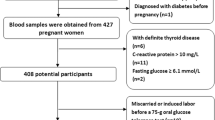Abstract
Gestational diabetes is one of the most common diseases in pregnancy. In the present work, the possible relationship between serum selenium concentration and gestational diabetes was investigated. Blood samples of 234 pregnant women were collected, including 98 subjects with impaired glucose tolerance (IGT), 46 subjects with gestational diabetes mellitus (GDM), and 90 normal pregnant women (NPW). An additional 17 samples of normal women of fertile age (NW) were collected for comparison. The hydride generation atomic fluorescence spectrometry was used for selenium determination. The mean serum selenium levels obtained for each group were 0.0741±0.0167 mg/L for NPW, 0.0631±0.0132 mg/L for IGT, 0.0635±0.0120 mg/L for GDM, and 0.108±0.0170 mg/L for NW. Serum selenium levels were significantly lower in pregnant woman with IGT (p<0.001) and GDM (p<0.001) than in NPW. Furthermore, an inverse correlation between the serum selenium concentration and the gestational period was also observed. Selenium supplementation during gestation for pregnant women, especially with IGT and GDM, should be considered.
Similar content being viewed by others
References
A. Farhat, M. F. Picciano, C. J. Lammi-Keefe, and H. N. DeSilva, Evidence for altered selenium status in pregnant women with diabetes, J. Trace Elements Exp. Med. 8, 29–39 (1995).
O. Ezaki, The insulin like effect of selenate in rat adipocytes, J. Biol. Chem. 265, 1124–1126 (1990).
A. M. Smith and M. F. Picciano, Evidence for increased selenium requirement for the rat during pregnancy and lactation, J. Nutr. 116, 1068–1070 (1986).
L. Han and S.-M. Zhou, Effect of selenium supplement on prevention of pregnancy-induced hypertension, China Med. J. 107, 870–871 (1994).
C. Hadrzynski, Diabetes and trace elements, J. Trace Elements Exp. Med. 12, 367–374 (1999).
C. Douillet, A. Tabib, M. Bost, et al., Selenium in diabetes, J. Trace Elements Exp. Med. 12, 379–392 (1999).
E. Bouzyk, T. Iwanenko, N. Tarocewiez, et al. Antioxidant defense system in differentially hydrogen peroxide sensitive L5178Y sublines, J. Free Radical Biol. Med. 22, 697–704 (1997).
J. F. Qin, Diabetes and trace elements, Guang Dong Sci. Trace Elements 7, 1–15 (2000).
M. Navarro-Alarcon, H. Lopez-G de la Serrana, V. Perez-Valero, and C. Lopez-Martinez, Serum and urine selenium concentrations as indicators of body status in patients with diabetes mellitus, Sci, Total Environ. 228, 79–85 (1999).
E. Ferrer, A. Alegria, R. Barbera, R. Farre, M. J. Lagarda, and J. Monleon, Whole blood selenium content in pregnant women, Sci. Total Environ. 227, 139–143 (1999).
Author information
Authors and Affiliations
Rights and permissions
About this article
Cite this article
Tan, M., Sheng, L., Qian, Y. et al. Changes of serum selenium in pregnant women with gestational diabetes mellitus. Biol Trace Elem Res 83, 231–237 (2001). https://doi.org/10.1385/BTER:83:3:231
Received:
Accepted:
Issue Date:
DOI: https://doi.org/10.1385/BTER:83:3:231




